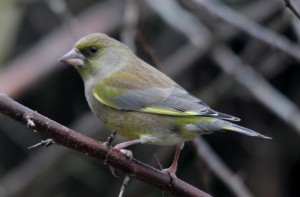 The recent cold spells has led to an increase in some garden birds coming to feeders as they start to cope with the winter months. Some is the operative word as, for example, there have been differences between the two birds that have distinctive yellow and green plumage. The siskin, the smallest of the two, is just not coming into gardens these days. Readers have reported that up until a few weeks ago one or two males and females were at the feeders whereas now there are none. One can only assume that these very attractive small birds are finding “wild” natural food elsewhere and they have a wide choice. Whilst at the garden feeders they will frequent nyjer, peanuts and mixed seed feeders, in the wider countryside they will take seeds from a wide variety sources. The most frequent are the seeds of spruce end pine trees but they will also take seeds from birch and alder, the latter is a favourite source. They will also take the seeds of dandelion, dock and thistles.
The recent cold spells has led to an increase in some garden birds coming to feeders as they start to cope with the winter months. Some is the operative word as, for example, there have been differences between the two birds that have distinctive yellow and green plumage. The siskin, the smallest of the two, is just not coming into gardens these days. Readers have reported that up until a few weeks ago one or two males and females were at the feeders whereas now there are none. One can only assume that these very attractive small birds are finding “wild” natural food elsewhere and they have a wide choice. Whilst at the garden feeders they will frequent nyjer, peanuts and mixed seed feeders, in the wider countryside they will take seeds from a wide variety sources. The most frequent are the seeds of spruce end pine trees but they will also take seeds from birch and alder, the latter is a favourite source. They will also take the seeds of dandelion, dock and thistles.
The other green and yellow bird, and one that is larger and most robust, is the greenfinch. Reports coming in indicate that in the last three weeks or so, in fact since the weather dipped to minus two degrees one night, the greenfinches have suddenly appeared in larger numbers at the feeders. They will, with their stout beaks, take a range of food from peanuts and mixed seed to sunflower hearts, the latter is one of their great favourites. They will not take the very tiny nyjer seeds but this is not because they do not like them. The reason is that the mesh of a normal nyjer feeder may well be small but such birds as goldfinches and siskins can get through. The beak of the greenfinch is much too large for such a task. However, I have seen them take nyjer seed from seed spilled onto the trays under the feeders.
As with many other garden birds it is very difficult to know just how many are coming to feeders. What we see at any one time may be only a fraction as there is so much coming and going. For example, in one garden near Inverness a bird ringer was ringing, amongst other birds, greenfinches. Over a period of just a month he ringed over 150 greenfinches despite the fact that any one time he could only see eight birds at the feeders. No doubt these sort of figures would apply to other birds such as chaffinches and goldfinches. The photograph, taken in my garden, shows the typical green and yellow plumage of the greenfinch and the large beak
Unlike many other farmland birds, greenfinches have increase in numbers in recent years. There may be a number of factors but one is that many more people are putting out food in gardens and the greenfinches have readily taken to this abundant food source. Only one farmland practice seem to be in favour of greenfinches these days and that is the increase in oil seed rape in some areas. The Scottish estimate is between 120,000 and 250,000 pairs and still increasing. They are fairly sedentary but some birds, indicated by ringing, move out of the Highlands in the winter. Intriguingly some greenfinches come in for the winter from such places as Scandinavia and even Russia.
Local names for the greenfinch include Green Linnet and Green Grosbeak, the latter after its large beak. Scots names include Greenie, Green Linnet or Lintie whilst the Gaelic name is Glaisean-daraic which means “Grey-headed one of the oak tree”
Tags: highland birds
